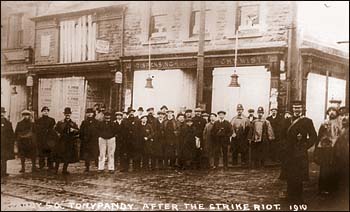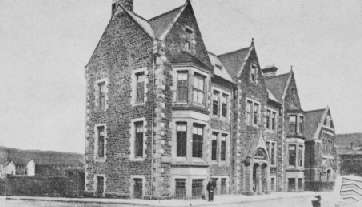|
Llwynypia
Llwynypia ( cy, Llwynypia ) is a village and community (Wales), community (and electoral ward) in Rhondda Cynon Taf, Wales, near Tonypandy in the Rhondda Fawr Valley. Before 1850 a lightly populated rural farming area, Llwynypia experienced a population boom between 1860 and 1920 with the sinking of several coal mines after the discovery of large coal deposits throughout the Rhondda, Rhondda Valleys. The Welsh language, Welsh name means "the Grove (nature), grove of the Magpie" or "Magpie's Bush" and was taken from the name of a farm that once existed in the area. Early history Situated on the River Rhondda Fawr where the river changes direction from south-east to southerly, Llwynypia holds evidence of human habitation from the Bronze Age through to modern times. On Mynydd y Gelli, a hill overlooking the area to the west, lies the Iron Age settlement of Hen Dre'r Gelli, a site which also has several Bronze Age cairns. In 1850 the first mine was sunk in the upper Rhondda in Tre ... [...More Info...] [...Related Items...] OR: [Wikipedia] [Google] [Baidu] |
Llwynypia Hospital
Llwynypia Hospital ( cy, Ysbyty Llwynypia) was a health facility in Llwynypia, Rhondda Cynon Taf, Wales. It was managed by the Cwm Taf Morgannwg University Health Board. History The facility has its origins an old subsidiary workhouse which was completed in 1903. An infirmary was added in 1909 and it became a general hospital in 1927 before joining the National Health Service as Llwynypia Hospital in 1948. As the only village with maternity facilities in the Rhondda, most residents from the area over the last century have Llwynypia as their place of birth on their birth certificates. After services transferred to the new Ysbyty Cwm Rhondda, Llwynypia Hospital closed in January 2010. References {{authority control Hospitals in Rhondda Cynon Taf Hospitals established in 1903 1903 establishments in Wales Hospital buildings completed in 1903 Buildings and structures in Rhondda Cynon Taf Defunct hospitals in Wales ... [...More Info...] [...Related Items...] OR: [Wikipedia] [Google] [Baidu] |
Rhondda
Rhondda , or the Rhondda Valley ( cy, Cwm Rhondda ), is a former coalmining area in South Wales, historically in the county of Glamorgan. It takes its name from the River Rhondda, and embraces two valleys – the larger Rhondda Fawr valley (''mawr'' large) and the smaller Rhondda Fach valley (''bach'' small) – so that the singular "Rhondda Valley" and the plural are both commonly used. The area forms part of the South Wales Valleys. From 1897 until 1996 there was a local government district of Rhondda. The former district at its abolition comprised sixteen communities. Since 1996 these sixteen communities of the Rhondda have been part of Rhondda Cynon Taf County Borough. The area of the former district is still used as the Rhondda Senedd constituency and Westminster constituency, having an estimated population in 2020 of 69,506. It is most noted for its historical coalmining industry, which peaked between 1840 and 1925. The valleys produced a strong Nonconformist movemen ... [...More Info...] [...Related Items...] OR: [Wikipedia] [Google] [Baidu] |
Archibald Hood
Archibald Hood (June 1823 – 27 October 1902) was a Scottish engineer and coalowner who became an important figure in the industrial growth of the Rhondda Valley. The son of a colliery official, Hood would make his name as a coalowner of collieries first in Scotland and later in Llwynypia in South Wales. History Early history Hood was born in June 1823 in Kilmarnock, Ayrshire. His father was a colliery foreman. His mother had died, so Hood's father brought him up alone, and he received little education – aged thirteen he was employed at his father's colliery.Carpenter (2000) p. 26 At the age of 17, after his father was promoted to colliery manager, Hood was able to take classes and qualified as a mining engineer. In 1856 Hood began expanding his business; leasing Whitehill Colliery at Rosewell (then owned by Archibald Primrose, 4th Earl of Rosebery). His successes in expanding and improving the Rosewell colliery allowed Hood to expand his operations, and he soon managed s ... [...More Info...] [...Related Items...] OR: [Wikipedia] [Google] [Baidu] |
Tonypandy Riots
The Miners Strike of 1910-11 was an attempt by miners and their families to improve wages and living conditions in severely deprived parts of South Wales, where wages had been kept deliberately low for many years by a cartel of mine owners. What became known as the Tonypandy riots of 1910 and 1911 (sometimes collectively known as the Rhondda riots) were a series of violent confrontations between the striking coal miners and police that took place at various locations in and around the Rhondda mines of the Cambrian Combine, a cartel of mining companies formed to regulate prices and wages in South Wales. The disturbances and the confrontations were the culmination of the industrial dispute between workers and the mine owners. The term "Tonypandy riot" initially applied to specific events on the evening of Tuesday, 8 November 1910, when strikers smashed windows of businesses in Tonypandy. There was hand-to-hand fighting between the strikers and the Glamorgan Constabulary, which was ... [...More Info...] [...Related Items...] OR: [Wikipedia] [Google] [Baidu] |
Mynydd Y Gelli
Mynydd Y Gelli is one of the mountains that forms the Rhondda Valley in South Wales, United Kingdom. The name Mynydd Y Gelli is also loaned to the Iron Age burial site that lies on one of its sides above Tonypandy, Clydach Vale and Llwynypia. Another more grandiose name for the site is the Rhondda Stonehenge Stonehenge is a prehistoric monument on Salisbury Plain in Wiltshire, England, west of Amesbury. It consists of an outer ring of vertical sarsen standing stones, each around high, wide, and weighing around 25 tons, topped by connectin .... Mountains and hills of Rhondda Cynon Taf {{Rhondda-Cynon-Taff-geo-stub ... [...More Info...] [...Related Items...] OR: [Wikipedia] [Google] [Baidu] |
River Rhondda
The River Rhondda ( cy, Afon Rhondda) is a river in South Wales with two major tributaries, Rhondda Fawr (meaning ''big Rhondda'') and Rhondda Fach (meaning ''little Rhondda''). Description The river has two major tributaries, the ''Rhondda Fawr'' and the ''Rhondda Fach'' (respectively, the "big" and the "little" Rhondda). Despite these names, both tributaries are of similar length. Both valleys display the U-shape cross-sections typical of glaciated valleys, having been eroded during successive ice ages. They cut deeply into the thick South Wales Coal measures which comprise sandstones and mudstones and coal seams of Carboniferous age. The whole form of the river and its surrounding urbanisation has been dominated by coal mining and the communities that grew up to exploit the rich coal seams. Much of the valley has suffered severe subsidence because of the removal of coal from beneath the valley floor. The houses and streets have subsided with the result that river levels are, ... [...More Info...] [...Related Items...] OR: [Wikipedia] [Google] [Baidu] |
William Abraham (Welsh Politician)
William Abraham (14 June 1842 – 14 May 1922), universally known by his bardic name, Mabon, was a Welsh trade unionist and Liberal-Labour (UK), Liberal/Labour politician, and a member of parliament (MP) from 1885 to 1920. Although an MP for 35 years, it was as a trade unionist that Abraham is most well known. Initially a pioneer of trade unionism, who fought to enshrine the principle of workers' representation against the opposition of the coal-owners, he was regarded in later life as a moderate voice believing that disputes should be solved through conciliation rather than industrial action. This drew him into conflict with younger and more militant leaders from the 1890s onwards. Although the defeat of the miners in the Welsh coal strike of 1898 was a clear defeat for Mabon's strategy, his prestige was sufficient to ensure that he became the first president of the South Wales Miners' Federation which was established in the wake of the dispute. Abraham was noted for his powerfu ... [...More Info...] [...Related Items...] OR: [Wikipedia] [Google] [Baidu] |
Miners' Institute
Miners' institutes, sometimes known as ''workingmen's institutes'', ''mine workers' institutes'', or ''miners' welfare halls'' are large institutional buildings that were typically built during the height of the industrial period as a meeting and educational venue. More commonly found in Britain, miners' institutes were owned by miner groups who gave a proportion of their wage into a communal fund to pay for the construction and running of the building. The institutes would normally contain a library, reading room and meeting room. Miners' institutes of North and South Wales During the late 19th century, with the population growth seen in former rural communities, many industrialised areas saw workers contributing to funds to build institutes. This was typified in the southern coalfield of Wales, which by 1910 saw institutes built in most towns and villages.''The Welsh Academy Encyclopaedia of Wales''. John Davies, Nigel Jenkins, Menna Baines and Peredur Lynch (2008) pg558 The ... [...More Info...] [...Related Items...] OR: [Wikipedia] [Google] [Baidu] |
British Admiralty
The Admiralty was a department of the Government of the United Kingdom responsible for the command of the Royal Navy until 1964, historically under its titular head, the Lord High Admiral – one of the Great Officers of State. For much of its history, from the early 18th century until its abolition, the role of the Lord High Admiral was almost invariably put "in commission" and exercised by the Lords Commissioner of the Admiralty, who sat on the governing Board of Admiralty, rather than by a single person. The Admiralty was replaced by the Admiralty Board in 1964, as part of the reforms that created the Ministry of Defence and its Navy Department (later Navy Command). Before the Acts of Union 1707, the Office of the Admiralty and Marine Affairs administered the Royal Navy of the Kingdom of England, which merged with the Royal Scots Navy and the absorbed the responsibilities of the Lord High Admiral of the Kingdom of Scotland with the unification of the Kingdom of Great ... [...More Info...] [...Related Items...] OR: [Wikipedia] [Google] [Baidu] |
Scotland
Scotland (, ) is a country that is part of the United Kingdom. Covering the northern third of the island of Great Britain, mainland Scotland has a border with England to the southeast and is otherwise surrounded by the Atlantic Ocean to the north and west, the North Sea to the northeast and east, and the Irish Sea to the south. It also contains more than 790 islands, principally in the archipelagos of the Hebrides and the Northern Isles. Most of the population, including the capital Edinburgh, is concentrated in the Central Belt—the plain between the Scottish Highlands and the Southern Uplands—in the Scottish Lowlands. Scotland is divided into 32 administrative subdivisions or local authorities, known as council areas. Glasgow City is the largest council area in terms of population, with Highland being the largest in terms of area. Limited self-governing power, covering matters such as education, social services and roads and transportation, is devolved from the Scott ... [...More Info...] [...Related Items...] OR: [Wikipedia] [Google] [Baidu] |
Treherbert
Treherbert () is a village and community situated at the head of the Rhondda Fawr valley in the county borough of Rhondda Cynon Taf, Wales. Historically part of Glamorgan, Treherbert is a former industrial coal mining village which was at its economic peak between 1850 and 1920. Treherbert is the upper most community of the Rhondda Fawr and encompasses the districts of Blaencwm, Blaenrhondda, Tynewydd and Pen-yr-englyn. Pronunciation 'Tre-Herbert' or 'Tre Herbert' is correctly pronounced as in 'Tre Herbert'. 'Tre' is a mutation of the Welsh word ‘Tref’, meaning ‘town’, derived from the word for a homestead or hamlet under old Cymric law. ‘Herbert’ was the surname of the Earls of Pembroke, a dynasty of local magnates. History There is evidence of settlements in the Rhondda dating back to Celtic times, but prior to the Industrial Revolution and the advent of coal mining the villages of Treherbert, Tynewydd, Blaenrhondda and Blaencwm consisted of a number of isolated ... [...More Info...] [...Related Items...] OR: [Wikipedia] [Google] [Baidu] |




